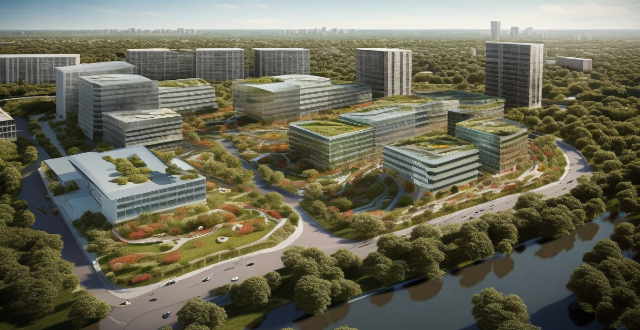Urban planning is crucial for managing urban growth and ensuring sustainable development. One area where it can make a significant impact is in biodiversity conservation, which is essential for maintaining ecosystem services such as pollination and water purification. Strategies for incorporating biodiversity conservation into urban planning include creating green spaces and parks, promoting sustainable transportation, implementing effective water management practices, encouraging waste reduction and recycling programs, and engaging communities in conservation efforts. By adopting these strategies, cities can become more livable while supporting both human well-being and biodiversity conservation.

How Can Urban Planning Contribute to Biodiversity Conservation?
Urban planning plays a crucial role in shaping the landscape of our cities and towns. It is an essential tool for managing urban growth, ensuring sustainable development, and improving the quality of life for residents. One area where urban planning can make a significant impact is in biodiversity conservation. Biodiversity refers to the variety of life on Earth, including plants, animals, and microorganisms. In this article, we will explore how urban planning can contribute to biodiversity conservation.
Importance of Biodiversity Conservation
Biodiversity is essential for maintaining ecosystem services such as pollination, water purification, and climate regulation. It also provides cultural and recreational benefits to humans. However, urbanization has led to habitat loss, fragmentation, and degradation, which threaten biodiversity. Therefore, it is crucial to incorporate biodiversity conservation into urban planning to mitigate these negative impacts.
Strategies for Biodiversity Conservation in Urban Planning
1. Green Spaces and Parks
Green spaces and parks are vital components of urban planning that can contribute significantly to biodiversity conservation. These areas provide habitats for various plant and animal species, promote ecological connectivity, and enhance the aesthetic value of cities. Some strategies for incorporating green spaces and parks into urban planning include:
- Preserving Natural Habitats: Identify and protect existing natural habitats within urban areas, such as wetlands, forests, and grasslands.
- Creating New Green Spaces: Allocate land for new parks and green spaces in urban plans, ensuring they are strategically located to maximize ecological benefits.
- Connecting Green Spaces: Design green corridors or networks that connect different green spaces, promoting ecological connectivity and allowing species to move freely between habitats.
2. Sustainable Transportation
Sustainable transportation systems can help reduce the negative impacts of urbanization on biodiversity by reducing air pollution, conserving energy, and minimizing habitat fragmentation. Some strategies for incorporating sustainable transportation into urban planning include:
- Promoting Public Transit: Develop efficient public transit systems that reduce the need for private vehicles, thus reducing emissions and congestion.
- Encouraging Active Transportation: Create safe and accessible infrastructure for walking and cycling, reducing reliance on motorized transport.
- Implementing Low-Emission Zones: Restrict high-emission vehicles from certain areas or times, improving air quality and reducing noise pollution.
3. Water Management
Proper water management is crucial for maintaining healthy ecosystems within urban areas. Strategies for incorporating water management into urban planning include:
- Protecting Water Bodies: Preserve natural water bodies such as lakes, rivers, and ponds, ensuring they are not contaminated or destroyed by urban development.
- Restoring Aquatic Habitats: Rehabilitate degraded aquatic habitats through measures like wetland restoration and riparian buffer zones.
- Stormwater Management: Implement stormwater management techniques like rain gardens, permeable pavement, and green roofs to reduce runoff and improve water quality.
4. Waste Management
Effective waste management is essential for maintaining clean environments and conserving biodiversity. Strategies for incorporating waste management into urban planning include:
- Recycling and Composting: Encourage recycling and composting programs to reduce waste generation and promote resource recovery.
- Green Building Practices: Promote green building practices that minimize waste during construction and operation, using eco-friendly materials and energy-efficient technologies.
- Waste Reduction Education: Educate residents about the importance of waste reduction and proper disposal methods to minimize environmental impacts.
5. Community Engagement
Community engagement is vital for successful biodiversity conservation efforts in urban areas. Strategies for incorporating community engagement into urban planning include:
- Educational Programs: Develop educational programs that raise awareness about biodiversity conservation among residents, schools, and local organizations.
- Citizen Science Projects: Encourage citizen science projects that involve residents in monitoring and protecting local biodiversity.
- Collaborative Partnerships: Foster partnerships between government agencies, non-governmental organizations (NGOs), and community groups to collaborate on biodiversity conservation initiatives.
In conclusion, urban planning has a significant role to play in biodiversity conservation. By incorporating strategies such as green spaces and parks, sustainable transportation, water management, waste management, and community engagement into urban planning processes, we can create more livable cities that support both human well-being and biodiversity conservation.